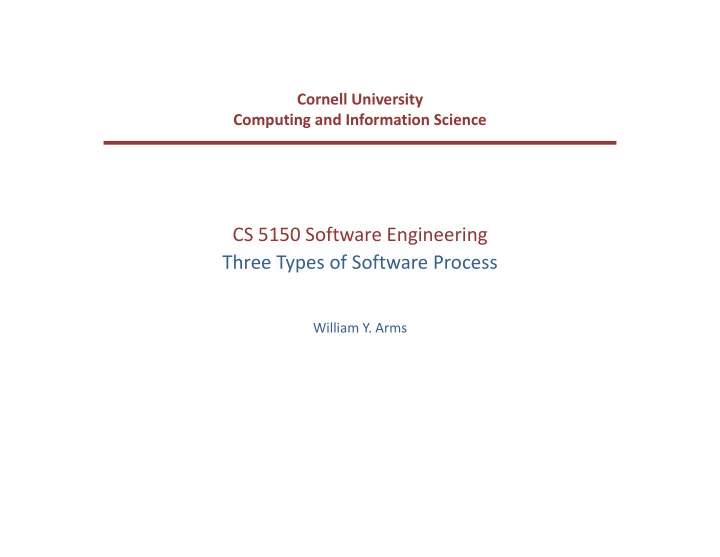

Cornell ¡University Computing ¡and ¡Information ¡Science CS ¡5150 ¡Software ¡Engineering ¡ Three ¡Types ¡of ¡Software ¡Process ¡ William ¡Y. ¡Arms
Types ¡of ¡Software ¡Process The ¡basic ¡ process ¡steps ¡ can ¡be ¡combined ¡in ¡many ¡ways ¡to ¡create ¡a ¡successful ¡ software ¡process ¡ for ¡software ¡development. ¡This ¡course ¡emphasizes ¡three ¡ types ¡of ¡process: ¡ • ¡ ¡ ¡Sequential ¡(Modified ¡Waterfall ¡Model) ¡ • ¡ ¡ ¡Iterative ¡refinement ¡ • ¡ ¡ ¡Incremental ¡(Agile) ¡ The ¡process ¡chosen ¡for ¡a ¡particular ¡system ¡depends ¡on ¡many ¡factors ¡including ¡ the ¡type ¡of ¡software ¡product ¡and ¡the ¡business ¡practices ¡of ¡the ¡client’s ¡ organization. ¡ ¡ The ¡development ¡of ¡a ¡major ¡system ¡may ¡use ¡all ¡three ¡methods ¡in ¡various ¡ combinations, ¡including: ¡ • ¡ ¡ ¡Phased ¡development ¡ • ¡ ¡ ¡Spiral ¡development
Sequential ¡Development: ¡The ¡Waterfall ¡Model Requirements Feasibility ¡study Requirements Design System ¡design Implementation Program ¡design Implementation ¡(coding) There ¡are ¡problems ¡ Program ¡testing with ¡this ¡basic ¡model ¡ Acceptance ¡& ¡release and ¡it ¡is ¡rarely ¡used ¡in ¡ practice. Operation ¡& ¡maintenance
Discussion ¡of ¡the ¡Waterfall ¡Model The ¡waterfall ¡model ¡is ¡a ¡heavyweight ¡process ¡with ¡full ¡ documentation ¡of ¡each ¡process ¡step. Advantages: ¡ • ¡ ¡ ¡ ¡Process ¡visibility • ¡ ¡ ¡ ¡Separation ¡of ¡tasks • ¡ ¡ ¡ ¡Quality ¡control ¡at ¡each ¡step • ¡ ¡ ¡ ¡Cost ¡monitoring ¡at ¡each ¡step Disadvantages: ¡ In ¡practice, ¡each ¡stage ¡in ¡the ¡process ¡reveals ¡new ¡understanding ¡ of ¡the ¡previous ¡stages, ¡which ¡often ¡requires ¡the ¡earlier ¡stages ¡to ¡ be ¡revised. The ¡Waterfall ¡Model ¡is ¡not ¡flexible ¡enough.
Discussion ¡of ¡the ¡Waterfall ¡Model A ¡pure ¡sequential ¡model ¡is ¡impossible Examples: ¡ ¡ • ¡ A ¡feasibility ¡study ¡cannot ¡create ¡a ¡proposed ¡budget ¡and ¡schedule ¡without ¡a ¡ ¡ preliminary ¡study ¡of ¡the ¡requirements ¡and ¡a ¡tentative ¡design. • ¡ Detailed ¡design ¡and ¡implementation ¡reveal ¡gaps ¡in ¡the ¡requirements ¡ ¡ specification. • ¡ Requirements ¡and/or ¡technology ¡may ¡change ¡during ¡the ¡development. ¡ The ¡plan ¡must ¡allow ¡for ¡some ¡form ¡of ¡iteration.
Modified ¡Waterfall ¡Model Feasibility ¡study Waterfall ¡model ¡with ¡ feedback ¡ Requirements This ¡is ¡better System ¡design Program ¡design Implementation ¡(coding) Program ¡testing Acceptance ¡& ¡release Operation ¡& ¡maintenance
Sequential ¡Development Sequential ¡processes ¡work ¡best ¡when ¡the ¡requirements ¡are ¡well ¡understood ¡ and ¡the ¡design ¡is ¡straightforward, ¡e.g., ¡ • ¡Conversions ¡of ¡manual ¡data ¡processing ¡systems ¡where ¡the ¡requirements ¡ were ¡well ¡understood ¡and ¡few ¡changes ¡were ¡made ¡during ¡the ¡development ¡ (e.g., ¡electricity ¡billing). ¡ • ¡New ¡models ¡of ¡a ¡product ¡where ¡the ¡functionality ¡is ¡closely ¡derived ¡from ¡an ¡ earlier ¡product ¡(e.g. ¡automatic ¡braking ¡system ¡for ¡a ¡car). ¡ • ¡Portions ¡of ¡a ¡large ¡system ¡where ¡some ¡components ¡have ¡clearly ¡defined ¡ requirements ¡and ¡are ¡clearly ¡separated ¡from ¡the ¡rest ¡of ¡the ¡system. ¡
Contracts Note ¡about ¡contracts ¡for ¡software ¡development ¡ Some ¡organizations ¡contract ¡for ¡software ¡development ¡by ¡placing ¡separate ¡ contracts ¡for ¡each ¡stage ¡of ¡the ¡Waterfall ¡Model ¡or ¡arrange ¡for ¡payment ¡after ¡ each ¡stage. ¡ ¡This ¡is ¡a ¡very ¡bad ¡practice.
Iterative ¡Processes Concept • ¡ Create ¡a ¡ prototype ¡system ¡early ¡in ¡the ¡development ¡process. • ¡ Review ¡the ¡prototype ¡with ¡clients ¡and ¡test ¡it ¡with ¡users, ¡to ¡improve ¡ the ¡understanding ¡of ¡the ¡requirements ¡and ¡clarify ¡the ¡design. • ¡ Refine ¡the ¡prototype ¡in ¡a ¡series ¡of ¡iterations. Requirements ¡are ¡hard ¡to ¡understand ¡until ¡there ¡is ¡an ¡operational ¡ system, ¡particularly ¡with ¡user ¡interfaces. Mistakes ¡in ¡the ¡requirements ¡are ¡the ¡most ¡expensive ¡to ¡correct. Example: ¡ ¡ ¡ • ¡ Converting ¡a ¡national ¡archive ¡from ¡paper ¡based ¡to ¡computer ¡based.
Iterative ¡Refinement Design Requirements Implementation Review Release
Discussion ¡of ¡Iterative ¡Refinement This ¡is ¡a ¡medium ¡weight ¡process ¡with ¡documentation ¡created ¡during ¡the ¡ process. Iterative ¡refinement ¡uses ¡various ¡techniques ¡that ¡enable ¡the ¡client ¡to ¡ review ¡the ¡the ¡planned ¡system ¡early ¡during ¡development: • ¡ ¡ ¡User ¡interface ¡mock-‑up • ¡ ¡ ¡Throw-‑away ¡software ¡components • ¡ ¡ ¡Dummy ¡modules • ¡ ¡ ¡Rapid ¡prototyping • ¡ ¡ ¡Successive ¡refinement Get ¡something ¡working ¡as ¡quickly ¡as ¡possible, ¡for ¡client ¡and ¡user ¡ evaluation, ¡but ¡do ¡not ¡release ¡it. ¡
Iterative ¡Refinement ¡with ¡a ¡Large ¡System Review ¡ ¡ may ¡be ¡ ¡ continuous Initial ¡ Version Requirements Outline ¡ Intermediate ¡ Design Description Versions Implementation Final ¡ Version
Incremental ¡Development: ¡Agile Sprint ¡2 Sprint ¡1 Sprint ¡3 Release ¡ Release Release Sprint ¡1 Sprint ¡3 Sprint ¡2 The ¡project ¡is ¡divided ¡into ¡a ¡large ¡number ¡of ¡small ¡tasks, ¡known ¡as ¡ sprints . • • For ¡each ¡sprint, ¡a ¡team ¡works ¡through ¡a ¡full ¡software ¡development ¡cycle ¡ including ¡planning, ¡requirements ¡analysis, ¡design, ¡coding, ¡testing, ¡and ¡ acceptance ¡testing, ¡and ¡release. • Each ¡sprint ¡is ¡completed ¡in ¡a ¡fixed ¡time ¡period, ¡e.g., ¡four ¡weeks. • The ¡size ¡of ¡an ¡sprint ¡is ¡based ¡on ¡team ¡size, ¡e.g., ¡5-‑10 ¡people.
Incremental ¡Development Advantages • ¡Pay-‑back ¡on ¡investment ¡begins ¡soon. • ¡Requirement ¡are ¡more ¡clearly ¡understood ¡in ¡developing ¡subsequent ¡ sprints ¡– ¡minimize ¡waste. • ¡ ¡Feedback ¡from ¡customers ¡and ¡clients ¡can ¡be ¡incorporated ¡in ¡later ¡ phases. It ¡is ¡easier ¡for ¡a ¡small ¡team ¡to ¡develop ¡a ¡small ¡sprint ¡correctly ¡than ¡to ¡ coordinate ¡large ¡projects ¡with ¡many ¡ramifications.
Incremental ¡Development ¡of ¡Online ¡Systems When ¡ software ¡is ¡released ¡online ¡it ¡is ¡often ¡possible ¡to ¡divide ¡it ¡into ¡ small ¡increments ¡that ¡are ¡developed ¡and ¡released ¡in ¡quick ¡succession. Example: ¡ ¡ ¡ • ¡ ¡Start-‑up ¡company ¡developing ¡a ¡web ¡based ¡service. This ¡is ¡a ¡lightweight ¡process ¡with ¡minimal ¡documentation ¡created ¡during ¡ the ¡process. Incremental ¡development ¡is ¡not ¡suitable ¡for ¡shrink ¡wrapped ¡software, ¡ embedded ¡systems, ¡or ¡other ¡situations ¡where ¡small ¡releases ¡are ¡not ¡ appropriate.
Recommend
More recommend